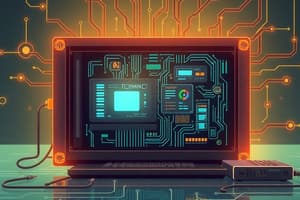Podcast
Questions and Answers
What are the parts of an information system?
What are the parts of an information system?
- People, procedures, software, hardware, and software
- People, procedures, software, hardware, data, and Internet (correct)
- People, procedures, software, hardware, and Internet
- People, procedures, hardware, data, and Internet
What is the distinction between system software and application software?
What is the distinction between system software and application software?
- System software manages the computer hardware, while application software serves specific user tasks (correct)
- System software is used for internet browsing, while application software manages the computer hardware
- System software is used for word processing, while application software manages the computer hardware
- System software serves specific user tasks, while application software manages the computer hardware
What are the three kinds of system software programs?
What are the three kinds of system software programs?
- Operating systems, word processors, and device drivers
- Operating systems, internet browsers, and device drivers
- Operating systems, utilities, and device drivers (correct)
- Operating systems, utilities, and spreadsheets
What are the four types of computers?
What are the four types of computers?
What are the types of computer hardware components?
What are the types of computer hardware components?
What is the difference between basic and specialized application software?
What is the difference between basic and specialized application software?
What are the three kinds of system software programs?
What are the three kinds of system software programs?
What are the four types of microcomputers?
What are the four types of microcomputers?
What is the function of communication devices in computer hardware?
What is the function of communication devices in computer hardware?
What is the primary purpose of system software?
What is the primary purpose of system software?
Flashcards are hidden until you start studying
Study Notes
Parts of an Information System
- Comprises hardware, software, data, procedures, and people.
- Each component plays a crucial role in managing and processing information.
System Software vs. Application Software
- System software serves as a bridge between hardware and user applications, managing system resources.
- Application software allows users to perform specific tasks (e.g., word processing, browsing).
Kinds of System Software
- Operating Systems: Manage computer hardware and software resources (e.g., Windows, Linux).
- Utility Software: Performs maintenance tasks (e.g., virus scanners, disk cleanup tools).
- Firmware: Specialized software programmed into hardware components (e.g., BIOS).
Types of Computers
- Supercomputers: Extremely powerful, used for complex computations (e.g., weather forecasting).
- Mainframe Computers: High-capacity systems for bulk data processing (e.g., banking transactions).
- Minicomputers: Mid-range systems supporting multiple users (e.g., manufacturing control).
- Microcomputers: Personal computers for individual use (e.g., laptops, desktops).
Types of Computer Hardware Components
- Input Devices: Tools that allow data entry (e.g., keyboard, mouse).
- Output Devices: Tools that present data (e.g., monitors, printers).
- Storage Devices: Hardware for storing data (e.g., hard drives, SSDs).
- Motherboard: Central circuit board connecting all components.
- CPU: The processor executing instructions and performing calculations.
Basic vs. Specialized Application Software
- Basic Application Software: General-purpose tools for common tasks (e.g., Microsoft Word).
- Specialized Application Software: Designed for specific industries or tasks (e.g., CAD for engineering).
Four Types of Microcomputers
- Desktop Computers: Stationary systems for personal use.
- Laptops: Portable computers with integrated components.
- Tablets: Mobile devices with touchscreen interfaces.
- Smartphones: Handheld devices with advanced computing capabilities.
Function of Communication Devices in Computer Hardware
- Facilitate data exchange between computers and networks (e.g., modems, routers).
- Enable online communication and connectivity.
Primary Purpose of System Software
- To control and manage computer hardware and software resources effectively.
- Provide a platform for running application software.
Studying That Suits You
Use AI to generate personalized quizzes and flashcards to suit your learning preferences.




